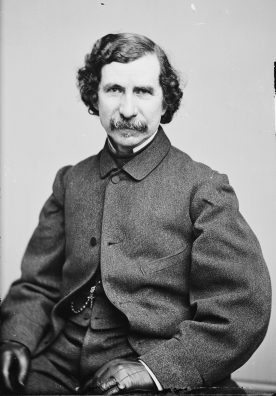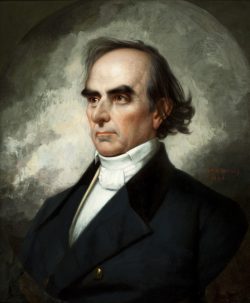G. P. A. Healy, from a photograph circa 1855–1865 by Mathew Brady, Brady-Handy Photograph Collection, Library of Congress Prints and Photographs Division.

George P. A. Healy 1813–1894
Born in Boston, George Peter Alexander Healy was the son of an Irish sea captain. He taught himself to paint portraits and in 1830 opened a studio in his hometown with the encouragement of painter Thomas Sully and of Jane Stuart, daughter of famed portraitist Gilbert Stuart. Four years later, an influential local patron sponsored Healy’s journey to Paris, where he worked briefly under French painters Antoine-Jean Gros and Thomas Couture. From them and from his study of paintings in the Louvre museum, Healy learned to portray sitters with a fluid naturalism then little known among American painters at home. In 1839 French king Louis Philippe commissioned Healy to paint his portrait, the first of a series of royal commissions that took the artist to England and back to the U.S. to create likenesses of statesmen and dignitaries. Several of these formed the basis for two large history paintings, one of which earned a gold medal at the Exposition Universelle in Paris in 1855.
That same year Chicago mayor William B. Ogden invited Healy to open a studio in his city. The acclaimed artist’s arrival in Chicago galvanized its fledgling art life and coincided with the first significant efforts to establish local art organizations and exhibitions. During his dozen years there Healy painted some five hundred portraits of Chicagoans and also traveled often to Washington, D.C., and elsewhere to fulfill commissions, among them numerous official portraits of Civil War commanders.
According to accounts by his daughter and granddaughter, Healy returned to Europe in 1867 partly to escape the volume of commissions that flooded his way. Based in Rome until 1872 and in Paris thereafter, he traveled across the Continent painting crowned heads as well as Pope Pius IX and celebrated figures in society, the arts, and politics. On numerous return visits to the U.S. he painted portraits of presidents and other distinguished sitters. By the 1880s, however, Healy’s style was increasingly eclipsed by the dashing, painterly manner popularized by a younger generation of artists. Healy returned to Chicago in 1892. He continued to paint until his death two years later, when he was honored as one of the founders of the city’s art life.
Wendy Greenhouse, PhD
